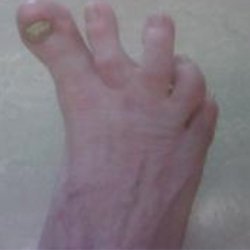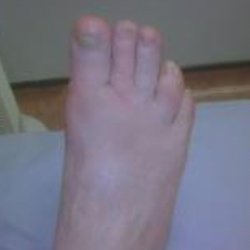Toe problems
Many patients attend The London Podiatry Centre complaining of claw toes, hammer or mallet toes. Other conditions include overlapping toes, webbed toes and "cock up" toes. All of these deformities can be treated conservatively using such devices as custom silicone splints but usually, the only way to correct the deformity is by means of surgery. Most operations are performed under local anaesthetic with rapid recovery and return to work
Please visit our sister web site cornsurgery.com for more information as most corns form as a consequence of misshapen toes!
Before and After forefoot deformity surgery


Toe problems FAQ
What do you need to know about a hammertoe?
Hammer toes form as a consequence of an imbalance in the function of the toe. Sometimes the cause is genetic, whilst in other cases, hammertoes are the result of ill-fitting footwear. At The London Podiatry Centre, we determine the cause for the hammertoe so that the best treatment can be considered.
Where is the bend in a hammertoe?
There are three joints in the toe. In a hammertoe, the bend occurs at the second. If the bend occurs at last joint, then it is a mallet toe.
Why is the joint nearest to the toenail called a mallet toe ?
because the end of the toe takes on a thickened appearance and therefore looks a bit like a mallet.
Can a mallet toe cause a hammertoe?
Yes, sometimes a mallet toe will form because of tight footwear and this can then also cause deformity at the first joint, leading to a hammertoe.
Is there a way to fix a hammertoe?
The only way to correct a hammertoe is through surgery. There is no splint that will correct a fixed hammertoe. At The London Podiatry Centre, surgery is performed under local anaesthetic on an outpatient basis.
How can I home treat my hammertoe?
The most important thing is to make sure that your shoes are the correct size. If you wear roomy shoes, even when s hammertoe has formed, you may not receive any pressure from the shoe, and as a consequence, you will feel no pain.
What kind of surgery is needed to correct a hammertoe?
In most cases hammertoe surgery involves cutting of bone and removing a small section of the toe to straighten it. At The London Podiatry Centre, we usually also rebalance the tendons to make sure that an optimal result is achieved.
What are the risks of hammertoe surgery?
All foot surgery involves a degree of risk. Typically, such risks include pain, swelling, infection, thrombosis, recurrence, regression, complex pain, nerve pain and abnormal scarring. In addition, some toes can remain very swollen (sausage toe). Reassuringly however, most patients who undergo hammertoe surgery are very pleased with the result and the risk of complication is small.
Is it possible to have a hammertoe?
Yes, a hammertoe is simply a description for a fixed deformity at the second joint in the toe. (the proximal interphalangeal joint)
What kind of toe problems can be solved with foot surgery?
There are a vast array of different toe deformities that can be fixed with surgery. This ranges from web toes to hammertoes and mallet toes. Nail problems can also be addressed with surgery.
What is a hammertoe?
A hammertoe is when there is an abnormal bend in the middle joint of a toe. It causes the toe to bend upwards.
Will my hammertoe go away?
A hammertoe will not mend on its own. In fact, it will probably worsen over time.

